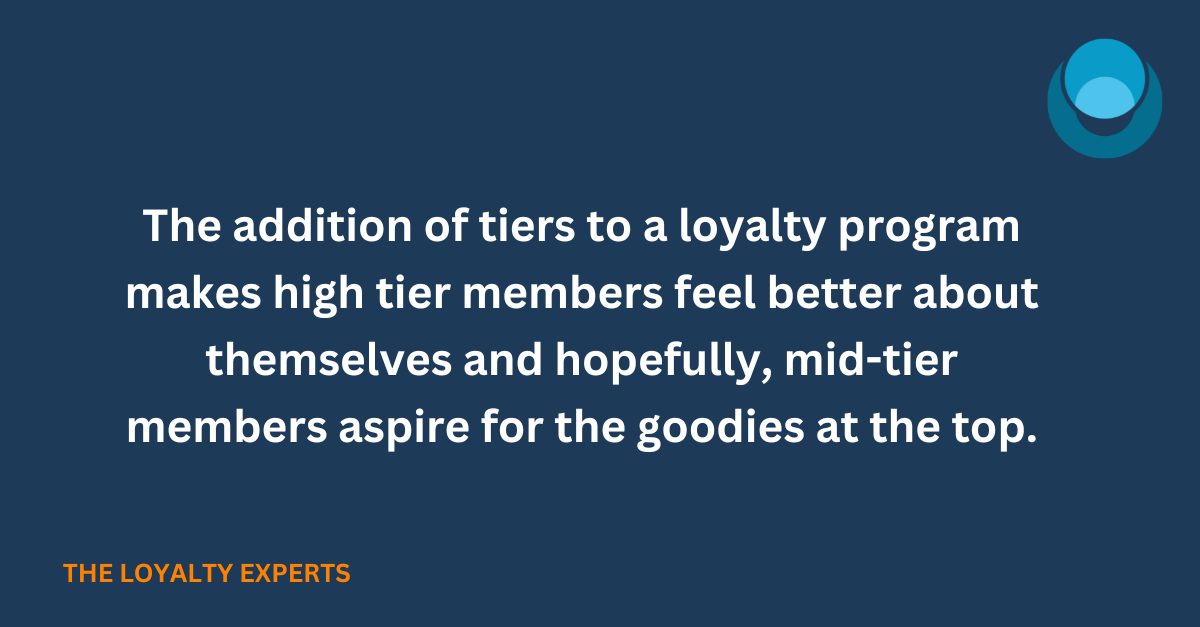Is Tiering Right for Your Loyalty Program?

Here at Ellipsis, we have designed or redesigned over 200+ loyalty programs, in a range of markets and cultures. We are regularly asked by our clients ‘should we have tiers in our loyalty program?’.
Program tiers simplify (and publicise) segmentation and increase the ability to create customer differentiation. There are many more benefits to tier a loyalty program…
- Tiered loyalty programs help align benefit value to customer value: This reduces exposure to costly services and benefits, particularly among some of your less engaged, less valuable customers.
- Tiered loyalty programs can help align benefit value to customer expectations: high value customers have expectations of exclusivity and privileged access, and entry level customers are typically more focused on transactional value.
- Tiered loyalty programs are a great way to drive aspiration amongst members and increase spending: This is achieved by the promise of unique benefits and incentivising additional spend from high value customers.
To tier or not to tier…
The critical questions are:
“Are my program’s headline rewards so valuable and alluring that customers will accommodate the extra complication of tiers?” and
“Does the cost of my rewards require sustained purchasing by members to justify the expense?”
If you answer yes to these questions tiers should be considered. High-value rewards that take time to earn make tiers acceptable to engaged members and reinforce progress towards the tangible and emotional goals members set.
Tiering is not the right answer for all programs. A ‘one for all’ program with a single value proposition for the entire member base, such as grocery programs Flybuys or Everyday Rewards, does not need to create differentiation amongst members, customers who spend more are automatically rewarded more richly.
Programs that aspire to offer a base program with a premier level offering will benefit from tiering, either invitation only, or by subscription. Commonly tiered programs can be seen in retail with multiple tiers, determined by spend or frequency thresholds and with increasing value of benefits. In the travel industry programs are often highly segmented, with the program further enriched by additional elements, such as unpublished invitation-only tiers or premium/subscription layers. Significantly different levels of customer value justify the various levels of service generosity.
For a tiered program to be successful the right business model and the right customer environment are required. At Ellipsis, we know there should be potential for scaled spending. Customers can increase spending, rather than reaching a natural cap. It is important that customer value distribution is broad. Visit frequency and spend levels should be for entry-level and best customers, aligned with your distinct levels of investment. We know that customer expectations are demanding. Where service is a priority, tiers allow high-cost service to be delivered to smaller audience (vs. low price models with mass market service delivery).
The addition of tiers to a program makes high tier members feel better about themselves and hopefully, mid-tier members aspire for the goodies at the top.
Best Practices in Loyalty Program Tier Design
The ‘tier or not to tier, that is the question’ dialogue always take place in the context of the basic best practices of programs.
- Right Structure: The program design should be tied to behaviours that profitably grow your business. Clearly define the value to be delivered in each tier and align this to your customer value distribution. If a linear relationship exists between customer spending and customer value, tiers may not be needed. If a specific group of customers are significantly different in behaviour and value, tiers are indicated; contrast once a year holiday flyer versus every week corporate road warrior in travel programs.
- Right Operations: Program rules should be easy to understand by the customer and easy to implement. The program must consistently deliver on all published promises. Consider surprise and delight and recognise customers with unpublished promises.
- Right Benefits: Leverage benefits unique to your brand to create differentiation and balance the programs core value proposition with differentiating features. Consider premium experiences and exclusive benefits for high value members and define clear scaling of value as customers migrate up tiers.
Tier benefits should be customised to maximise the value in customer segments.

Tiering is an important discussion in any loyalty program design and do not forget that any new loyalty proposition must appeal to both the heads and hearts of members, and appealing to member’s ego does not hurt.
As part of the Ellipsis program design process, we apply proven methodologies and data-driven insights, to grow long-term value and optimise performance. We call this Customer Science®.
We are Ellipsis, the Loyalty Experts. We help you find, understand, measure, manage and grow customer value. We’re here to help, please get in touch…

